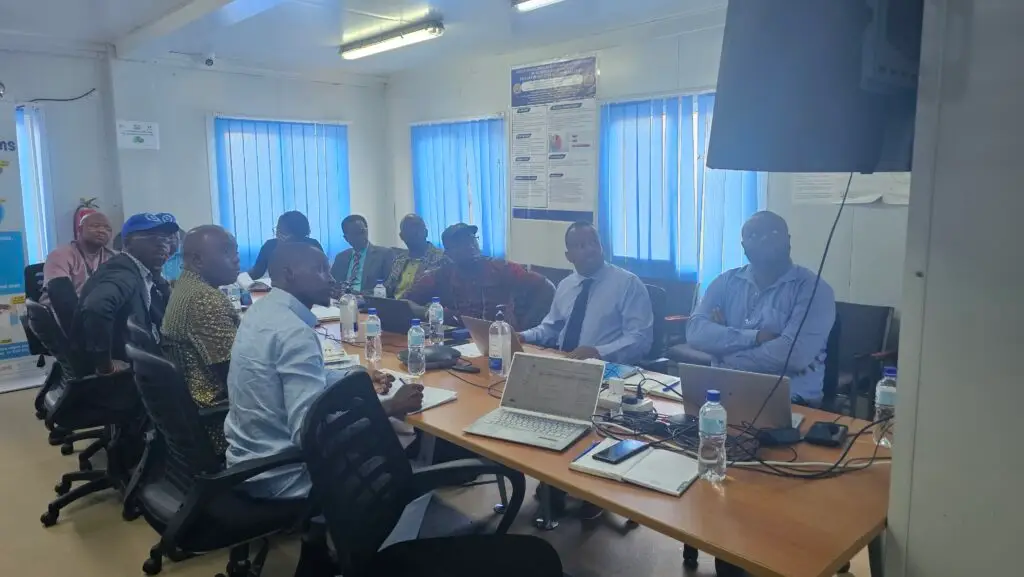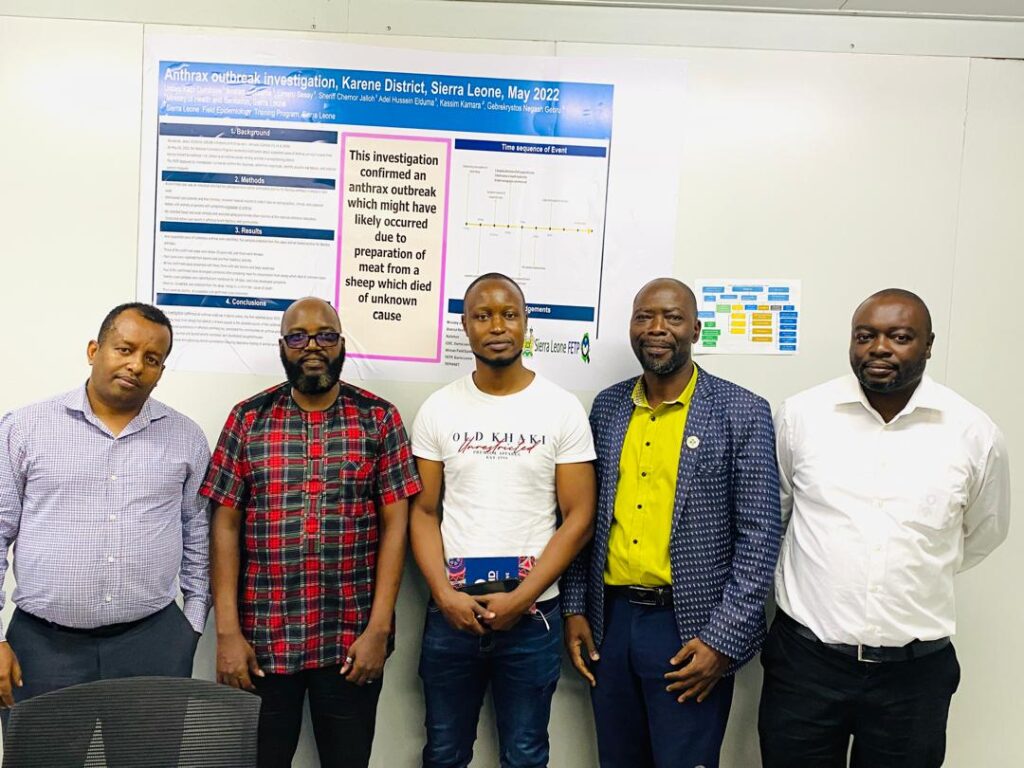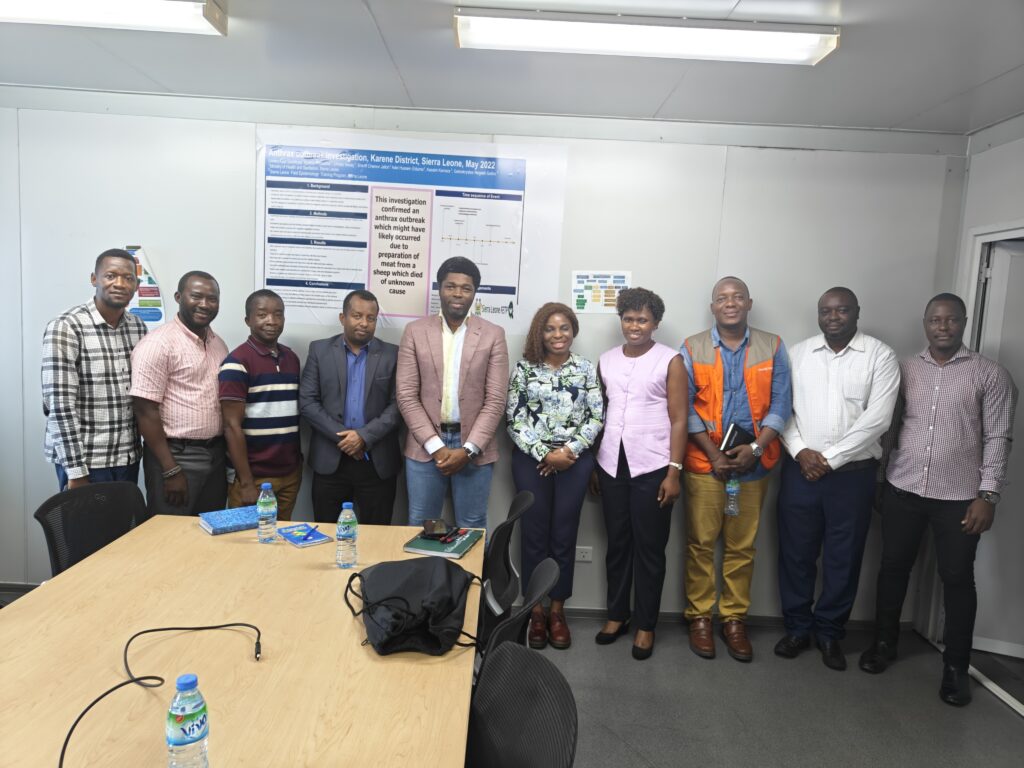Strengthening Public Health Together!
On April 24, 2025, the Sierra Leone Field Epidemiology Training Program (FETP) Steering Committee convened a meeting at the Emergency Operations Center (EOC), chaired by ED. Professor Foday Sahr. The meeting brought together key stakeholders, including representatives from the University of Sierra Leone, Njala University, the US CDC, and other public health partners. The primary focus of discussions was the introduction of the Advanced FETP. This new initiative aims to elevate the training standards for public health professionals, ensuring they are well equipped to tackle epidemiological challenges effectively. In the coming weeks, we will be issuing a Notice of Interest inviting training institutions that are interested in hosting the Advanced FETP to apply. This is a significant opportunity for institutions to contribute to the enhancement of public health capabilities in Sierra Leone.
SCHISTOSOMIASIS OUTBREAK AND RISK FACTORS OF INFECTION AMONG SCHOOL CHILDREN IN KOINADUGU DISTRICT, SIERRA LEONE, MARCH 2023
Binta Bah, Paul. S. Mansaray, Umaru Sesay, Alfered. S. Fomba, Joel. F. Mansaray, P. Gibateh, S. Fornie, S. T. Yonda, M. B. Jalloh, Philip. P. Gevao, James. S. Squire, Joseph. S. Kanu, Alhaji. U N’jai, Adel. H. Elduma, Gebrekrstos Negash Gebru ABSTRACT Schistosomiasis, a parasitic infection caused by Schistosoma species, is among the neglected tropical diseases and is a public health problem, particularly in sub-Saharan Africa. On the 6th of March 2023, the Community Health Officer in Alkalia Community Health Center, Koinadugu district, reported an increased number of school children complaining of blood in their urine and stool. We investigated the cases to identify risk factors associated with the outbreak. We described the outbreak and conducted an unmatched case-control study (138 cases and 138 controls) to identify risk factors associated with it. We reviewed clinical records and interviewed cases and relatives to collect demographic, clinical, and epidemiological data. Urine and stool samples were collected to investigate the presence of Schistosoma haematobium and Schistosoma mansoni. Multivariate analysis was used to calculate adjusted odd ratios (aOR) at the 95% Confidence level to identify risk factors associated with the outbreak. A total of 421 suspected cases were identified; 71.7% (302) were males, and median age was 10 years (range: 2 to 50 years). Of the total, 62.7% (264) were positive for Schistosomiasis (S. heamatobium and mansoni), and 98.5% (260) were positive for Schistosomiasis haematobium. Almost 98% (260) of the positive cases were school children. Of the positive cases, 95% (252) were presented with bloody urine. The case-control study identified bathing 5.4 (1.8-16.1), and drinking river/stream water 6.6 (2.4-18.2) factors associated with Schistosomiasis outbreak at the multivariate level. This study confirmed a Schistosomiasis outbreak in the Koinadugu district, particularly among school-aged children. Risk factors associated with Schistosomiasis infection included drinking water from rivers or streams, bathing in rivers or streams, and exposure to the Teria River. We recommend providing clean and safe drinking water sources to limit exposure to rivers or streams, promote health education, and effectively distribute drugs. Keywords: Assessment, risk factors, Schistosomiasis outbreak, school children, Koinadugu, Sierra Leone
BUILDING A NEW GENERATION OF RESEARCHERS THROUGH THE FIELD EPIDEMIOLOGY TRAINING PROGRAM
Gebrekrstos Negash Gebru, Alhaji U. Njai, James Squire, Mohamed A. Vandi, Aiah Gbakima, Monique A. Foster, Foday Sahr Affiliations: 1 Sierra Leone Field Epidemiology Training Program 2 University of Sierra Leone 3 National Public Health Agency 4 African Field Epidemiology Network, 5 Centers for Disease Control and Prevention, Sierra Leone
EPIDEMIOLOGICAL ANALYSIS OF MENINGITIS, SUNYANI MUNICIPALITY, BONO REGION OF GHANA, 2019-2019: (A SECONDARY DATA ANALYSIS)
Solomon Aiah Sogbeh, Paul Dsane-Aidoo, Donne Ameme, Delia Bandoh, Gebrekrstos Negash Gebru, Adel Hussein Elduma, Regina Appia, Adolphina Addo-Lartey DOI: https://doi.org/10.4314.2.5 Abstract Background: Meningitis is a vaccine-preventable disease yet it remains a global public health issue that causes long-term disability and death. Ghana being located within the meningitis belt of African, the occurence of consistent outbreaks of Meningitis in different parts of Ghana has been a peculiar surveillance challenge. We analyzed the Sunyani Municipal meninigitis surveillance data to determine the incidence, describe disease pattern, fatality, and identify the Meningitis strain. Methods: We extracted meningitis surveillance data for January 2015 to December 2019 from the District Health Information Management System. We reviewed the annual meningitis line-list of the Sunyani Municipality Bono Region. Data were identified, cleaned and analysed using Microsoft Excel. We performed descriptive statistics on quantitative variables and estimated incidence rate and case fatality rates and determined the predominant strains. Results: From 2015-2019, 84 suspected cases were recorded with 17 laboratory confirmed in Sunyani and seven meningitis deaths. The overall incidence rate was 2/100,000 population, with a 7/17 (41.2%) case fatality rate. the highest incidence rate (8 per 100,000 population) was reported in 2016 while 2018 recorded the highest fatality rate of 2/2 (100%). We identified 12/17(70.6.%) of Streptococcus pneumoniae as the predominant Meningitis strain. Weekly reporting timeliness and completeness were below the World Health Organization recommended 80% reporting target. Conclusions: There was a high case fatality rate of Meningitis among the residents in Sunyani Municipality, and Streptococcus pneumoniaee was the predominant strain identified. The highest incidence was recorded in 2016 within the period studied. The timeliness and completeness of weekly reporting for the five years was also below the World Health Organization target. The Sunyani Municipal Health Directorate intensify their active case search of Meningitis, implement vaccination campaigns in high-risk areas and ensure prompt reporting to prevent future epidemics. Keywords: Meningitis, Sunyani Municipality, Streptococcus pneumonia
LASSA FEVER OUTBREAK INVESTIGATION IN TONKOLILI DISTRICT, MARCH 2022
Mohamed Salieu Bah, Alieu Tommy, Zainab Juhehbah, Adel Hussein Elduma, Kassim Kamara, Solomon Aiah Sogbeh, Gebrekrstos Negash Gebru DOI: https://doi.org/10.4314.2.3 Abstract Background: Lassa fever is an endemic zoonotic disease in West African countries, including Sierra Leone. On March 3, 2022, Tonkolili District Surveillance Unit received notification of suspected Lassa fever cases from a hospital. The Sierra Leone Field Epidemiology Training Program (SLFETP) trainees and mentors responded within 24 hours to confirm the diagnosis, identify sources, and institute control measures. Methods: We interviewed case patients and families using a case investigation form; reviewed patients’ records; collected blood specimens and sent them to the Reference Laboratory. Environmental assessment, rodent trapping, and an active case search were conducted, and 29 contacts were line-listed and monitored for 21 days. Result: Two suspected cases tested positive for Lassa fever. On February 25, 2022, a 5-year-old male (Case 1) developed fever, abdominal pain, and diarrhea, he was admitted to the hospital on March 1, 2022, and treated for malaria. He died on March 3, 2022, Lassa fever was suspected and later confirmed by Polymerase Chain Reaction (PCR) testing. An 8-year-old girl (Case 2) who developed skin rashes and fever on February 25, 2022, was treated with traditional herbs at home. She was admitted to the hospital on March 1, 2022, as her symptoms persisted and was treated for malaria. Two days later, Lassa fever was suspected, and the diagnosis was confirmed four days after admission. She died on the same day of laboratory confirmation. Both patients lived in the same household with no travel history. Poor environmental sanitation was observed around the patients’ households. No rodents were found, and no additional cases or symptomatic contacts were discovered. Conclusion: Two Lassa fever cases were confirmed in Tonkolili District. Late detection by healthcare workers likely contributed to the patient’s deaths. We sensitized healthcare workers on the Lassa fever case definition and recommended community education on early healthcare seeking. Keywords: Lassa fever, Disease outbreak, Zoonoses, Polymerase chain reaction, Sierra Leone.
The Ministry of Health, with support from the African Field Epidemiology Network, has successfully certified 200 data collectors following their participation in a groundbreaking study on psychoactive substance use.
Strengthening Public Health Together!

On April 24, 2025, the Sierra Leone Field Epidemiology Training Program (FETP) Steering Committee convened a meeting at the Emergency Operations Center (EOC), chaired by ED. Professor Foday Sahr. The meeting brought together key stakeholders, including representatives from the University of Sierra Leone, Njala University, the US CDC, and other public health partners. The primary focus of discussions was the introduction of the Advanced FETP. This new initiative aims to elevate the training standards for public health professionals, ensuring they are well equipped to tackle epidemiological challenges effectively. In the coming weeks, we will be issuing a Notice of Interest inviting training institutions that are interested in hosting the Advanced FETP to apply. This is a significant opportunity for institutions to contribute to the enhancement of public health capabilities in Sierra Leone.
AFENET Sierra Leone hosted the leadership of Action Against Hunger (ACF) to discuss possible areas of collaboration.

AFENET Sierra Leone and World Vision Leaders Discuss Strategic Partnerships

In a strategic meeting held at the AFENET Sierra Leone head office, key leaders from AFENET and World Vision came together to explore potential areas of collaboration and partnership. The focus of the discussion revolved around bolstering system strengthening initiatives, workforce development programs, digital health enhancements, and surveillance strategies in Sierra Leone.Both organizations shared insights on their respective expertise and resources, highlighting opportunities for synergies and joint efforts to address public health challenges in the region. The meeting aimed to lay the foundation for future collaborations that leverage the strengths of each organization to achieve greater impact and sustainable outcomes for the communities they serve.With a shared commitment to improving health systems and promoting community wellbeing, AFENET and World Vision are poised to forge a strategic partnership that will contribute significantly to the advancement of public health goals in Sierra Leone.1
The government of Sierra Leone, through the Ministry of Health and its development partners, including AFENET SL and the Carter Center, has launched a community-based survey on the prevalence of substance use and its impacts in Sierra Leone. The survey will be critical to planning for managing drug abuse problems.
